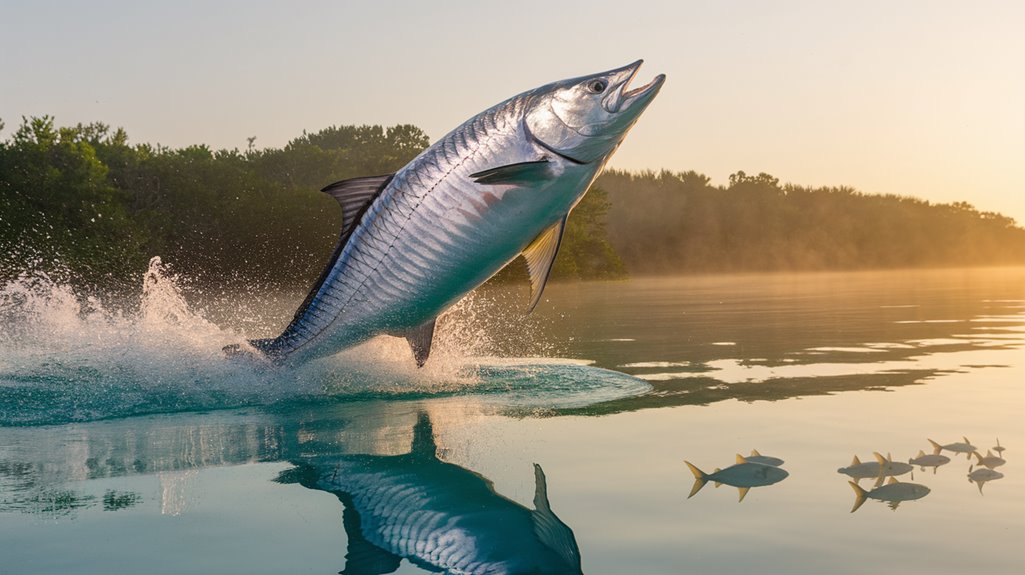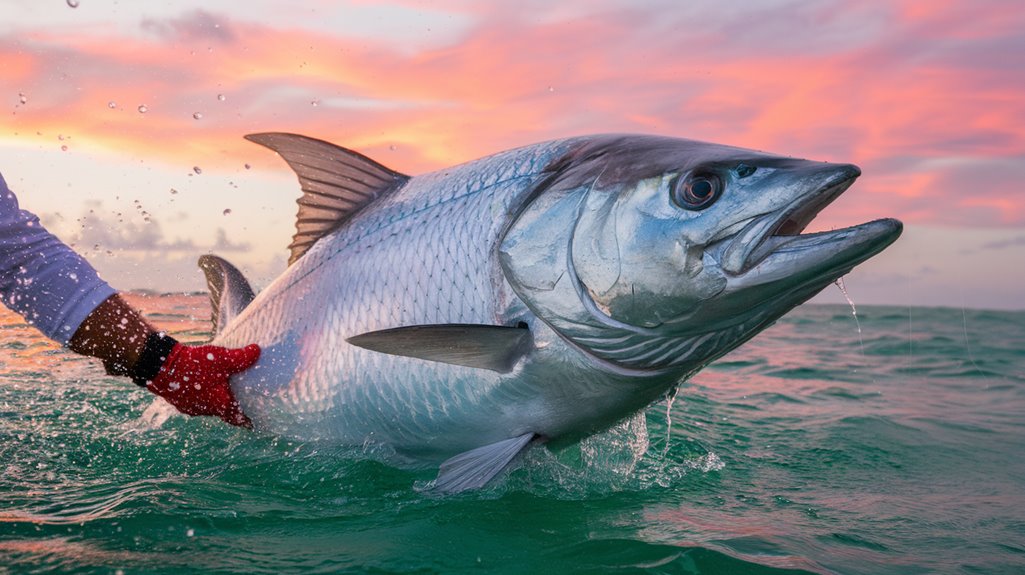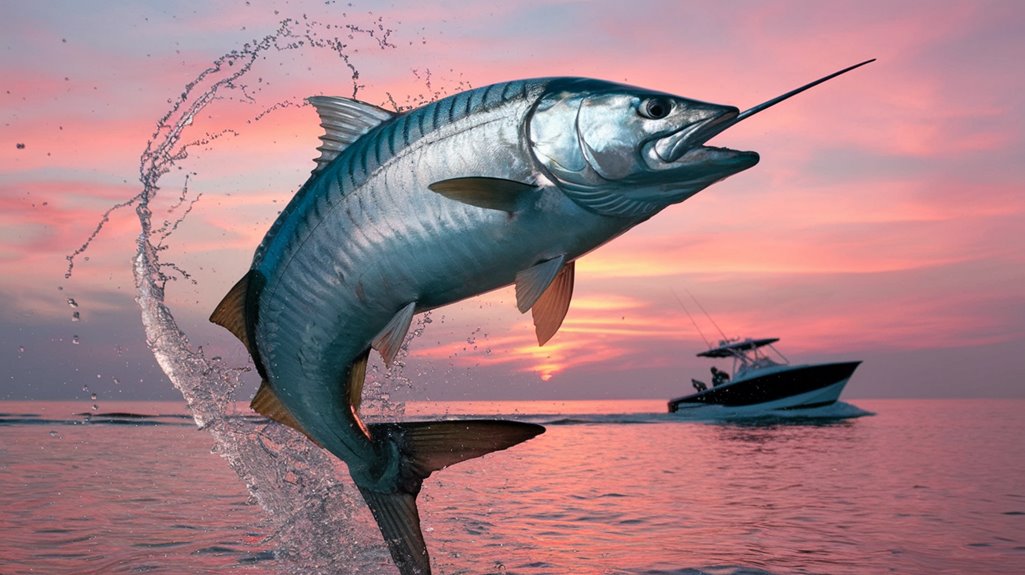You'll find few fishing experiences that match the raw power and spectacle of battling a tarpon in Fort Myers' waters. These prehistoric gamefish, often reaching weights over 150 pounds, command respect from even the most seasoned anglers. When you're connected to a silver king, you'll need every bit of technical skill and patience you've developed. Let's explore the essential tactics and local knowledge you'll need to land one of these magnificent creatures.
- Key Takeaways
- What Makes Tarpon the Ultimate Game Fish
- Essential Gear for Tarpon Fishing Success
- Prime Fishing Spots Around Fort Myers
- Understanding Tarpon Migration Patterns
- Mastering Catch-and-Release Techniques
- Weather Conditions and Seasonal Strategies
- Top Bait Choices for Trophy Tarpon
- Planning Your Fort Myers Fishing Adventure
- Conservation and Responsible Angling
- Local Charter Options and Expert Guidance
- Frequently Asked Questions
- Conclusion
Key Takeaways
- Fort Myers' prime tarpon fishing season runs April to June, with Boca Grande Pass serving as a major migration hub.
- Essential gear includes 30-50lb rod, 300+ yards of braided line, and circle hooks sized 5/0-10/0 for successful tarpon fishing.
- Target tarpon during early morning or late evening, maintaining 50 yards distance from pods for optimal stealth approach.
- Popular spots include Riverside Park, Tarpon Street Pier, and North Shore Park, offering excellent access to tarpon-rich waters.
- Practice catch-and-release techniques with minimal fight times and underwater photography to protect tarpon populations.
What Makes Tarpon the Ultimate Game Fish
When you're seeking the ultimate angling challenge in Fort Myers, nothing compares to battling the legendary Silver King. These majestic giants, reaching lengths over 7 feet and weights up to 300 pounds, define what makes an ultimate game fish. You'll witness spectacular acrobatic displays as tarpon launch themselves skyward, testing both your skill and equipment to the limit.
The peak fishing experience occurs from April to June, particularly around Boca Grande Pass, where tarpon migrate in impressive numbers. You'll need to master your technique to handle their blistering runs and extraordinary endurance. As a responsible angler, you'll participate in catch and release practices, ensuring future generations can experience the thrill of pursuing these magnificent creatures. Their raw power, combined with their aerial performances, creates an unmatched challenge that keeps anglers returning season after season.
Essential Gear for Tarpon Fishing Success
When you're targeting Fort Myers' legendary tarpon, you'll need a robust setup with a heavy-duty rod rated for 30-50 pound line and a matching reel with substantial drag capacity. You'll want to arm yourself with 7/0 to 10/0 circle hooks paired with fluorocarbon leaders, which provide the stealth and strength needed for these sophisticated predators. For boat gear essentials, keep a sturdy landing net or gaff within reach, along with hook removers and a proper measuring device to guarantee quick, safe releases of these magnificent gamefish.
Rod and Reel Selection
To successfully tackle the mighty tarpon in Fort Myers waters, you'll need a robust combination of rod and reel that can handle these powerful gamefish. Choose a heavy-action rod between 7 and 8 feet in length, perfectly suited for managing the explosive runs and aerial displays of these silver kings.
Your reel selection is equally critical. Opt for a high-capacity reel that holds at least 300 yards of 50-80 lb braided line. Pair this with a 60-100 lb fluorocarbon leader to withstand the abrasive nature of tarpon's bony mouths while maintaining stealth. Don't forget to arm yourself with circle hooks in sizes 5/0 to 8/0 – they're essential for secure hooksets and fish conservation. Before pursuing that trophy tarpon, verify your gear is thoroughly checked and maintained.
Essential Terminal Tackle
Success in tarpon fishing hinges on selecting the right terminal tackle setup, which forms the critical connection between your main line and the fish. You'll need to equip your rig with heavy-duty hooks in the 5/0 to 8/0 range to effectively penetrate a tarpon's tough mouth. Pair these with strong leader lines of 60-100 pound test fluorocarbon and robust swivels rated at 100 pounds minimum.
- Heavy-duty hooks designed specifically for tarpon's bony mouth structure
- Fluorocarbon leaders that maintain strength while remaining nearly invisible
- Premium-grade swivels and snaps to prevent twist and failure
- Strategic weight placement using egg sinkers for depth control
- Versatile terminal configurations for both live bait rigs and fly setups
Adapt your tackle choices to match current fishing conditions, whether you're working deep channels or shallow flats in Fort Myers waters.
Boat Equipment Must-Haves
Equipping your boat with five essential gear categories guarantees you're ready for the demanding world of Fort Myers tarpon fishing. Start with a robust rod and reel setup featuring 300+ yards of 50-80 lb test line to handle those explosive runs. Pair this with an 80-100 lb fluorocarbon leader line that withstands tarpon's abrasive mouths while maintaining stealth. Select razor-sharp 7/0 to 10/0 hooks specifically designed for tarpon fishing's challenging hook sets.
Stock your tackle box with versatile bait and lures, including live crabs, mullet, and proven artificials like Gator spoons. Don't overlook vital safety gear – properly fitted life jackets, a thorough first aid kit, and a high-capacity cooler are non-negotiable for any serious fishing trip. This equipment foundation maximizes your chances of landing these magnificent gamefish.
Prime Fishing Spots Around Fort Myers
Fort Myers boasts several premier fishing locations that offer diverse angling opportunities throughout the year. From the bustling Tarpon Street Pier to the serene Lakes Park, you'll find spots suited for every angling style and skill level.
- Riverside Park's floating dock positions you perfectly for targeting Snook and Tarpon in the Caloosahatchee
- Tarpon Street Pier provides quick river access, ideal for landing the silver kings during peak season
- North Shore Park combines family-friendly amenities with productive fishing from its well-maintained pier
- Manatee Park offers a unique kayak fishing experience while observing these gentle giants
- Lakes Park's expansive freshwater system delivers outstanding Bass fishing opportunities
These prime fishing spots showcase Fort Myers' rich angling diversity, whether you're seeking inshore action or freshwater excitement. Each location features distinct characteristics that'll enhance your fishing success throughout the seasons.
Understanding Tarpon Migration Patterns

To maximize your tarpon fishing success, you'll need to track their migration patterns from April through June when they move through Boca Grande Pass in massive numbers. You'll find the most productive fishing at Sanibel Island and Fort Myers Beach during this peak season, as these areas serve as natural funnels for migrating schools heading to their spawning grounds. Your catch rates will depend heavily on water temperatures and seasonal timing, with spring offering ideal conditions before the fish retreat to deeper Gulf waters as winter approaches.
Seasonal Movement And Timing
While tarpon can be found in Fort Myers waters throughout the year, your best shot at landing the "Silver King" comes during their peak migration from April through June. During these warmer months, you'll find massive schools congregating around Boca Grande Pass and the waters off Sanibel Island. Understanding these seasonal patterns is essential for planning your Southwest Florida fishing expedition.
- Peak tarpon fishing in Florida occurs April-June
- Large schools gather near Boca Grande Pass
- Sanibel Island and Fort Myers Beach waters teem with activity
- Winter months drive tarpon toward deeper waters for warmth
- Spring brings ideal fishing conditions as waters warm
As temperatures cool, these magnificent gamefish retreat to deeper Gulf waters, making winter catches more challenging. Time your expedition during the spring migration for the most productive tarpon fishing experience.
Peak Migration Hot Spots
Knowing where tarpon gather during their peak migration can greatly boost your chances of landing these prized gamefish. From April through June, you'll find the highest concentrations of tarpon moving through Boca Grande Pass, making it your prime target location. During this peak spawning period, substantial schools also congregate in the waters surrounding Sanibel Island and Fort Myers Beach, offering excellent fishing opportunities.
To maximize your fishing trips' success, focus on these proven hot spots when the spring migration is in full swing. Keep in mind that as winter approaches, these silver kings will shift to deeper Gulf waters. Understanding this movement pattern is essential – by positioning yourself at these key migration points during the right seasons, you'll markedly improve your odds of encountering these magnificent gamefish.
Environmental Factors Matter
Environmental factors drive tarpon behavior throughout the year in Southwest Florida waters. You'll notice these magnificent fish adjust their migration patterns based primarily on water temperature fluctuations. During spring and summer months, they'll move into the coastal waters around Fort Myers for spawning activities, making it prime time for your fishing endeavors.
- Water temperature serves as the primary trigger for tarpon movement patterns
- Peak migration occurs April through June near Boca Grande Pass
- Warmer months bring tarpon into shallow coastal zones
- Temperature drops push them toward deeper Gulf waters
- Spawning activities concentrate in warm, shallow areas
Understanding these environmental cues is critical for your success. By tracking water temperatures and seasonal patterns, you'll greatly improve your chances of encountering tarpon during their annual migrations through Fort Myers waters.
Mastering Catch-and-Release Techniques

Since Fort Myers offers world-class tarpon fishing, mastering proper catch-and-release techniques is essential for preserving these magnificent gamefish. You'll need to minimize fight times to under 30 minutes to prevent exhaustion and reduce the tarpon's vulnerability to predators. Always use barbless hooks for an easier release and less tissue damage.
When you've landed your catch, keep the fish in the water while photographing to minimize stress. To properly revive the tarpon, hold it upright and move it gently back and forth, allowing water to flow through its gills. Don't release until it shows strong signs of recovery. Remember that local regulations only permit harvest with a special tarpon tag for IGFA world record attempts, so proper catch-and-release practices aren't just recommended—they're required.
Weather Conditions and Seasonal Strategies
Successful tarpon fishing in Fort Myers hinges on understanding both seasonal migrations and daily weather patterns. You'll find peak fishing times from April to June when migratory tarpon flood the warm Gulf waters. During these months, target them during early morning or late evening hours for best results.
- Clear skies and mild winds create perfect visibility for spotting rolling tarpon
- Seasonal patterns shift during winter, pushing tarpon upriver to warmer waters
- Switch to inshore fishing strategies when targeting winter holdover fish
- Spring and summer offer the most consistent action in Southwest Florida
- Weather conditions directly impact tarpon feeding behavior and movement
Adapt your approach based on these seasonal variations and weather conditions. When conditions align – typically during the spring migration – you'll experience Fort Myers' legendary tarpon fishing at its finest.
Top Bait Choices for Trophy Tarpon
When you're targeting trophy tarpon in Fort Myers, you'll want to stock your live well with fresh mullet, pilchards, or crabs positioned up-current during the ebb tide. For artificial presentations, you can't go wrong with slow-retrieved Gator spoons or Mirrolure 77Ms that match the natural forage size of 3-5 inches. Remember to maintain stealth by staying at least 50 yards from visible tarpon pods, as these giants are easily spooked and require a tactical approach for consistent success.
Live Bait Selection Secrets
Mastering your live bait selection can make the difference between landing a trophy tarpon and going home empty-handed in Fort Myers waters. You'll need to focus on natural presentations that trigger aggressive strikes in the feeding zone. Position your live bait up-current during ebb tide, and you'll see better results as it drifts naturally to waiting tarpon.
- Shrimp without floats maintain natural swimming action
- Crabs, pilchards, and mullet provide diverse options
- Sharp hooks are essential for solid hook sets
- Present bait near individual tarpon or small pods
- Cast up-current to allow natural drift presentation
Remember to keep your hooks razor-sharp to penetrate their bony mouths. When you spot a rolling tarpon, cast your bait ahead of its path and let the current do the work. This stealthy approach maximizes your chances of success.
Artificial Lure Success Tips
Savvy Fort Myers anglers rely on specific artificial lures to land trophy tarpon, particularly during prime feeding periods. You'll want to stock your tackle box with Gator spoons, Mirrolure 65M or 77M, and small Rapala Magnums for ideal visibility in local waters. Remember to match your lure selection to current water conditions and tarpon behavior patterns.
Execute your casting lures with a stealthy approach, positioning your boat quietly near rolling fish or pods. Work these unweighted lures slowly through the water, mimicking natural prey movement that triggers strikes. For best results, time your trips during early morning or late evening hours when tarpon actively feed. These cooler periods often produce the most aggressive strikes, especially when you maintain proper lure presentation and match the predominant baitfish in size and color.
Planning Your Fort Myers Fishing Adventure
Ready to chase the legendary silver kings in Fort Myers? Planning your tarpon fishing expedition during peak season (April-June) enhances your chances of success, as massive schools migrate through Boca Grande Pass. You'll want to secure your spot with experienced fishing charters that know these waters intimately.
- Research local guides specializing in tarpon fishing techniques
- Book your trip during peak season for ideal conditions
- Study catch-and-release protocols to protect the fishery
- Scout prime locations near Sanibel Island and Fort Myers Beach
- Consider combining fishing with local ecotourism activities
For the best experience, focus your efforts on the productive waters where tarpon frequently roll on the surface. Your guide will help position you perfectly for those heart-pounding strikes. Remember to factor in tide schedules and moon phases when planning your dates, as these elements greatly influence tarpon behavior and feeding patterns.
Conservation and Responsible Angling
Because tarpon populations face increasing pressures from recreational fishing, it's critical that you follow Fort Myers' strict catch-and-release protocols. The Florida Fish and Wildlife Conservation Commission mandates sustainable practices, including keeping tarpon in the water for photos and limiting fight times to 30 minutes.
| Conservation Rule | Purpose | Your Action |
|---|---|---|
| Water Photography | Minimize Stress | Keep Fish Submerged |
| Fight Time Limit | Reduce Exhaustion | Monitor Your Clock |
| Proper Equipment | Prevent Injury | Use Circle Hooks |
As a responsible angler, you'll need a tarpon tag if you're pursuing a record catch. Otherwise, focus on proper handling techniques and swift releases. These fishing regulations guarantee future generations can experience the thrill of targeting these magnificent gamefish while maintaining healthy population levels.
Local Charter Options and Expert Guidance
Whether you're a novice seeking guidance or an experienced angler targeting trophy tarpon, Fort Myers' professional charter services provide the expertise needed for a successful expedition. Local charters like Caloosahatchee Cowboy and Endless Summer offer customizable experiences tailored to your skill level and preferences. Their professional guides leverage intimate knowledge of prime fishing spots and seasonal patterns to maximize your chances of landing trophy tarpon.
- Half-day and full-day trips available to suit your schedule
- Expert guidance for live bait, fly fishing, and light tackle techniques
- Top-quality fishing gear included with your charter
- Hands-on instruction to improve your angling skills
- Access to proven tarpon fishing locations throughout the season
The combination of expert guidance and local knowledge guarantees you'll get the most from your Fort Myers tarpon fishing adventure.
Frequently Asked Questions
What Is the Best Month to Fish Tarpon in Florida?
You'll find May's your prime month for Florida tarpon fishing, when massive schools migrate through Boca Grande Pass. Water temps are perfect, and you'll see peak feeding activity, especially during dawn and dusk.
Where to Catch Tarpon in Fort Myers?
With hundreds of tarpon rolling during peak season, you'll find excellent catches at Boca Grande Pass, Sanibel Island, Fort Myers Beach, and along the Caloosahatchee River, especially near bridge structures.
Why Is It Illegal to Catch Tarpon in Florida?
It's not illegal to catch tarpon in Florida – you just can't harvest them. They're protected species requiring catch-and-release, except with a special $50 tag for IGFA record attempts.
How Much Does It Cost to Go Tarpon Fishing in Florida?
If you're booking with Captain Mike in Naples during peak season, you'll spend $800-1,200 for a full-day tarpon charter. Standard half-day trips run $600-900, plus license fees if needed.
Conclusion
Whether you're battling a 150-pound silver king in Boca Grande Pass or sight-casting to rolling tarpon off Sanibel's beaches, you'll find Fort Myers' waters offer world-class action that'll test your mettle. Like the tides that shape our fishery, the future of these magnificent gamefish ebbs and flows with our conservation efforts. By mastering the techniques, respecting the resource, and partnering with local experts, you're ready to join the ranks of successful tarpon anglers.

